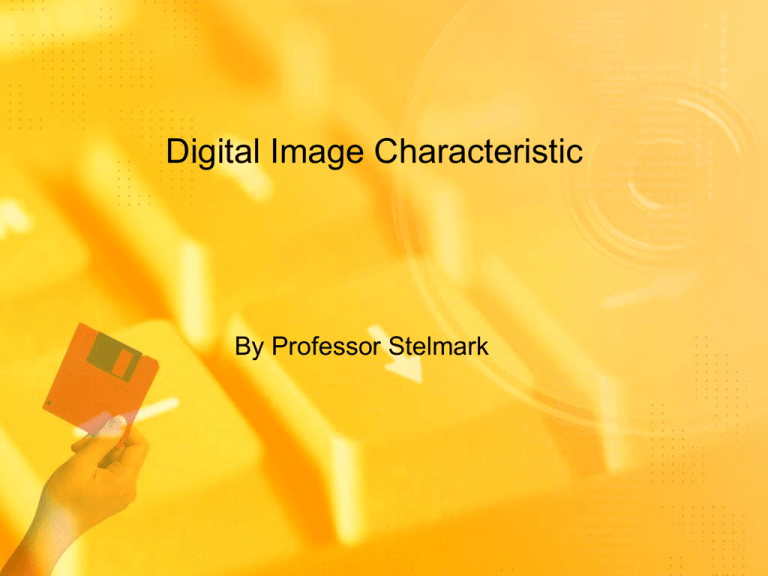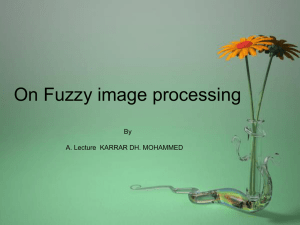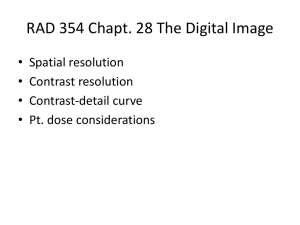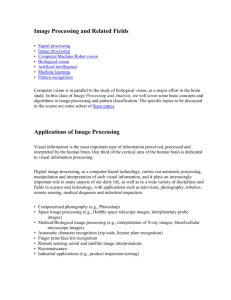Digital Imaging
advertisement

Digital Image Characteristic By Professor Stelmark Digital Imaging In digital imaging, the latent image is stored as digital data and must be processed by the computer for viewing on a display monitor. Digital imaging can be accomplished by using a specialized image receptor that can produce a computerized radiographic image. Two types of digital radiographic systems are in use today: computed radiography (CR) and direct digital radiography (DR). Regardless of whether the imaging system is CR or DR, the computer can manipulate the radiographic image in various ways after the image has been created digitally. A unique characteristic of digital image receptors is their wide dynamic range. Dynamic range refers to the range of exposure intensities an image receptor can accurately detect; this means that moderately underexposed or overexposed images may still be of acceptable diagnostic quality. Because the image is constructed of digital data and is viewed on a display monitor, it can exhibit a wider range of brightness or densities. As a result, anatomic areas of widely different x-ray attenuation, such as soft tissues and bony structures, can be more easily visualized on a digital image. Digital images are composed of numeric data that can be easily manipulated by a computer. When displayed on a computer monitor, there is tremendous flexibility in terms of altering the brightness (density) and contrast of a digital image. The practical advantage of such capability is that, regardless of the original exposure technique factors (within reason), any anatomic structure can be independently and well visualized. Computers can also perform various postprocessing image manipulations to improve visibility of the anatomic region further. A digital image is recorded as a matrix or combination of rows and columns (array) of small, usually square, “picture elements” called pixels. The size of the pixel is measured in microns (0.001 mm). Each pixel is recorded as a single numeric value, which is represented as a single brightness level on a display monitor. The location of the pixel within the image matrix corresponds to an area within the patient or volume of tissue For a given anatomic area, or field of view (FOV), a matrix size of 1024 × 1024 has 1,048,576 individual pixels; a matrix size of 2048 × 2048 has 4,194,304 pixels. Digital image quality is improved with a larger matrix size that includes a greater number of smaller pixels Although image quality is improved for a larger matrix size and smaller pixels, computer processing time, network transmission time, and digital storage space increase as the matrix size increases. The numeric value assigned to each pixel is determined by the relative attenuation of x-rays passing through the corresponding volume of tissue. Pixels representing highly attenuating tissues, such as bone, are usually assigned a low value for higher brightness than pixels representing tissues of low x-ray attenuation. Each pixel also has a bit depth, or number of bits that determines the amount of precision in digitizing the analog signal and therefore the number of shades of gray that can be displayed in the image. Bit depth is determined by the analog-todigital converter that is an integral component of every digital imaging system. Because the binary system is used, bit depth is expressed as 2 to the power of n, or the number of bits (2n). A larger bit depth allows a greater number of shades of gray to be displayed on a computer monitor. Binary digits are used to display the brightness level (shades of gray) of the digital image. The greater the number of bits, the greater the number of shades of gray, and the quality of the image is improved. A system that can digitize and display a greater number of shades of gray has better contrast resolution. An image with increased contrast resolution increases the visibility of recorded detail and the ability to distinguish among small anatomic areas of interest. A system that can digitize and display a greater number of pixels has better spatial resolution. An image with increased spatial resolution increases the visibility of recorded detail and the ability to resolve small structures. Pixel density The number of pixels per unit area The distance measured from the center of a pixel to an adjacent pixel determines the pixel pitch or pixel spacing Increasing the pixel density and decreasing the pixel pitch increases spatial resolution. Decreasing pixel density and increasing pixel pitch decreases spatial resolution. An important performance characteristic of an ADC is the sampling frequency, which determines how often the analog signal is reproduced in its discrete digitized form. Increasing the sampling frequency of the analog signal increases the pixel density of the digital data and improves the spatial resolution of the digital image The closer the samples are to each other (increased sampling frequency), the smaller the sampling pitch, or distance between the sampling points Increased sampling frequency decreases the sampling pitch and results in smaller-sized pixels. The distance between the midpoint of one pixel to the midpoint of an adjacent pixel describes the pixel pitch. Spatial resolution is improved with an increased number of smaller pixels resulting in a more faithful digital representation of the acquired analog image. Another important ADC performance characteristic is degree of quantization or pixel bit depth, which controls the number of gray shades or contrast resolution of the image. During the process of quantization, each pixel, representing a brightness value, is assigned a numeric value. Quantization reflects the precision with which each sampled point is recorded. The pixel size and pitch determine the spatial resolution, and the pixel bit depth determines the system's ability to display a range of shades of gray to represent the anatomic tissues. Pixel bit depth is fixed by the choice of ADC, and CR systems manufactured with a greater pixel bit depth (i.e., 14-bit [214 can display 16,384 shades of gray]) improve the contrast resolution of the digital image. With digital systems, the computer creates a histogram of the data set. The histogram is a graph of the exposure received to the pixel elements and the prevalence of the exposures within the image. This created histogram is compared with a stored histogram model for that anatomic part; VOIs are identified, and the image is displayed. Lookup Tables Following histogram analysis, lookup tables provide a method of altering the image to change the display of the digital image in various ways. Because digital IRs have a linear exposure response and a very large dynamic range, raw data images exhibit low contrast and must be altered to improve visibility of anatomic structures. Lookup tables provide the means to alter the brightness and grayscale of the digital image using computer algorithms. They are also sometimes used to reverse or invert image grayscale. If the image is not altered, the graph would be a straight line. If the original image is altered, the original pixel values would be different in the processed image and the graph would no longer be a straight line but might resemble a characteristic curve for radiographic film The level of radiographic contrast desired in an image is determined by the composition of the anatomic tissue to be radiographed and the amount of information needed to visualize the tissue for an accurate diagnosis. For example, the level of contrast desired in a chest image is different from the level of contrast required in an image of an extremity. Radiographic contrast or image contrast is a term used in both digital and filmscreen imaging to describe the variations in brightness and density. In digital imaging, the number of different shades of gray that can be stored and displayed by a computer system is termed grayscale. Because the digital image is processed and reconstructed in the computer as digital data, its contrast can be altered. Radiographic film images are typically described by their scale of contrast or the range of densities visible. A film image with few densities but great differences among them is said to have high contrast. This is also described as short-scale contrast. A radiograph with a large number of densities but few differences among them is said to have low contrast. This is also described as long-scale contrast.








